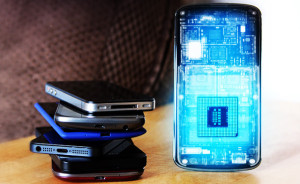 Researchers have found a new way to tune the radio frequency in smartphones and other wireless devices that promises to reduce costs and improve performance of semiconductors used in defense, satellite and commercial communications.
Researchers have found a new way to tune the radio frequency in smartphones and other wireless devices that promises to reduce costs and improve performance of semiconductors used in defense, satellite and commercial communications.
Semiconductor Research Corp. (SRC) and Northeastern University in Boston presented the research findings at the 58th Magnetism and Magnetic Materials Conference in Denver this week.
Nian Sun, associate professor of electrical and computer engineering at Northeastern, said he’s been working on the process since 2006, when he received National Science Foundation grants for the research.
“In September, we had a breakthrough,” he said in a telephone interview. “We didn’t celebrate with champagne exactly, but we were happy.”
The research progressed through a series of about 20 stages over the past seven years. It wasn’t like the hundreds of failures that the Wright brothers faced in coming up with a working wing design, but there were gradual improvements at each stage, he said.
Today, state-of-the art radio frequency circuits in smartphones rely on tuning done with radio frequency (RF) varactors, a kind of capacitor. But the new process allows tuning in inductors as well, which could enhance a smartphone’s tunable frequency range from 50% to 200%, Sun said. Tuning is how a device finds an available frequency to complete a wireless transmission. It’s not very different from turning a dial on an FM radio receiver to bring in a signal.
Most smartphones use 15 to 20 frequency channels to make connections for different applications, but the new inductors made possible by the research will potentially more than double the number of channels available in a single RF module, leading to more compact and powerful smartphones, Sun said. The new inductors are a missing link long sought for in ways to upgrade the RF tunable frequency range in a tuned circuit.
“Researchers have been trying a while to make inductors tunable – to change the inductance value – and haven’t been very successful,” said Kwok Ng, senior director of device sciences at SRC. He said SRC has worked with Northeastern since 2011 on the project, investing up to $450,000 in the research work.
How it worked: Researchers in a Northeastern lab used a piezoelectric layer to change the permeability of integrated magnetic inductors using microelectromechanical systems (MEMS) processes. Piezoelectricity is an electromechanical interaction between the mechanical and electric states in a crystalline material. A crystal can acquire a charge when subjected to AC voltage.
What the researchers found is they could apply the right amount of voltage on the piezoelectric layer to change the permeability of a magnetic core of the inductor. As the magnetic film changes permeability, the inductance of the inductors is changed, which in turn tunes the resonance frequency in a capacitor-inductor circuit.
Ng said the research means such tunable future inductors can be used to improve radio signal performance, which could eliminate the number of modules needed in a smartphone, with the potential to reduce the cost of materials.
Intel and Texas Instruments cooperated in the work, and the new inductor technology will be available for further industrial development by the middle of next year, followed by use in consumer applications by as earlier as late 2014.





